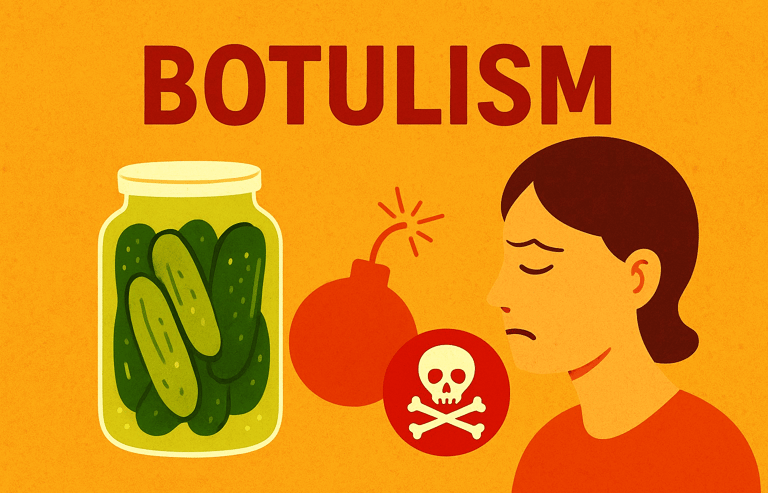Stay updated on what is trending in health. Discover tips and resources for a healthier, balanced life.
Botulism: A Rare but Serious Food Poisoning
Learn what botulism is, its causes, symptoms, treatment and prevention options. Discover how to prevent this rare but serious illness and protect your health.
DISEASES AND CONDITIONS
Dr. S. Ali
8/13/20254 min read


When most people think about food poisoning, they picture a rough day with nausea, diarrhea, and maybe a fever. But botulism? That’s in a completely different league.
This rare but dangerous illness can be life-threatening — and the scary part is, it doesn’t take much to get sick. Let’s break down what it is, how you can avoid it, and what to do if you think you’ve been exposed.
What Exactly Is Botulism?
Botulism is a type of food poisoning caused by a toxin produced by Clostridium botulinum bacteria. This toxin is one of the most powerful known to science — even a tiny amount can cause serious illness.
It’s not contagious, meaning you can’t catch it from someone else. Instead, you get it from eating or being exposed to the toxin directly.
Types of Botulism
There’s more than one way this illness can show up:
Foodborne botulism – Usually from improperly canned, preserved, or fermented foods.
Wound botulism – When the bacteria infect a wound and produce the toxin.
Infant botulism – Most often from babies ingesting spores (like in honey) that grow inside their intestines.
Inhalation botulism – Extremely rare, usually linked to laboratory accidents.
How Do You Get It?
The most common culprit is home-canned or preserved foods that weren’t processed correctly. The bacteria thrive in low-oxygen environments — like sealed jars — and produce their toxin without any obvious signs.
Other sources include:
Improperly canned foods – Home-canned vegetables, fruits, or meats that haven’t been processed at the right temperature can allow Clostridium botulinum spores to survive and grow. Even a small taste can cause severe illness, so always follow safe canning guidelines and discard any jars with bulging lids or strange odors.
Fermented or preserved fish – In some regions, certain traditional fish preparation methods can create low-oxygen environments perfect for toxin production. If these products aren’t prepared and stored under strict safety controls, they can carry a high risk of botulism. Refrigeration and proper salting can reduce the danger.
Infant botulism – Babies under 12 months are at risk because their immature digestive systems can allow Clostridium botulinum spores (from sources like dust, soil, or honey) to grow in the intestines and produce toxin. This is why health authorities advise not to give honey to babies under 12 months.
Wound contamination – If C. botulinum spores enter a deep wound, they can multiply and produce toxin directly in the body. This can happen after injuries that trap dirt or foreign material under the skin, especially if the wound is not properly cleaned. It’s more common in contaminated puncture wounds or crush injuries.
Fun fact (or maybe not so fun): You can’t see, smell, or taste the toxin.
Symptoms of Botulism
Blurred or double vision – One of the earliest warning signs, this happens because the toxin affects the nerves that control your eye muscles, making it hard for your eyes to work together.
Drooping eyelids – You might notice your eyelids starting to sag, making it difficult to keep your eyes open.
Slurred speech – As the toxin spreads, it can weaken the muscles used for talking, making your words sound unclear.
Difficulty swallowing – This can make eating and even drinking dangerous because of the risk of choking.
Muscle weakness – It often starts in the face and moves downward to the arms, legs, and breathing muscles.
Paralysis – In severe cases, the toxin can cause complete muscle paralysis, which may require mechanical ventilation.
Treatment
If botulism is suspected, doctors act fast. Treatment may include:
Antitoxin – Stops the toxin from causing more damage (but won’t reverse damage already done)
Hospital care – Sometimes including a ventilator if breathing muscles are affected
Wound care – If it’s from a wound infection
Recovery can take weeks to months because nerves need time to heal.
Prevention Tips
Follow safe canning guidelines – Always use pressure canners for low-acid foods and follow tested recipes to ensure the heat destroys spores.
Boil home-canned foods before eating – Heating canned food for 10 minutes before serving can destroy any botulinum toxin present.
Refrigerate foods promptly – Store perishable items in the fridge to prevent bacterial growth.
Avoid giving honey to babies – This simple rule can prevent infant botulism completely.
Practice wound care – Clean all cuts thoroughly and seek medical attention for deep wounds.
Recent Outbreaks in Italy: A Cautionary Tale
Italy has recently experienced alarming botulism outbreaks, highlighting how quickly this toxin can strike—even in modern settings.
Broccoli in Oil: Calabria, Southern Italy
In early August 2025, a tragic outbreak in Diamante, Calabria caused one death and nine hospitalizations. The culprit was broccoli stored in oil and served in sandwiches at a food truck. The authorities immediately activated emergency protocols, recalled the contaminated broccoli, and launched a criminal investigation. The botulism antidote was urgently flown to local hospitals to support treatment.
Guacamole at a Festival: Sardinia
Just weeks earlier, eight people fell ill after consuming guacamole at a festival in Sardinia. A woman tragically died, and a young boy was airlifted to Rome for treatment. Both outbreaks occurred in Italy’s southern regions and stemmed from contaminated prepared foods sold in mass gatherings.
Why Italy?
Italian home-canning traditions remain strong, especially in rural and southern regions. From 2001 to 2020, 452 lab-confirmed cases were reported, with preserved vegetables in oil accounting for nearly half.
These incidents serve as stark reminders: no food is safe unless handled correctly. Even industrial or street-food vendors can unknowingly fight an invisible enemy.
Public Health Perspective
Rapid response is vital. Italy’s outbreak response—recalls, antidote distribution, and investigations—was swift and organized.
Home preservation needs oversight. Education, regulation, and clearer guidelines can help prevent future cases. Studies show southern Italy has higher incidence due to homemade preserves.
Early signs save lives. Warning hospitals and Poison Control centers, and treating early with antidote are essential strategies.
Bottom Line
Botulism is rare but dangerously fast-acting, and the recent Italian outbreak is a stark reminder of how quickly it can strike. Prevention is key—store food safely, follow proper canning methods, and be extra cautious with preserved or street-sold foods. If you or someone you know develops sudden muscle weakness, vision changes, or trouble breathing after eating such foods, seek medical help immediately. With quick action, most people can make a full recovery.
Sources:
CDC – About Botulism
https://www.cdc.gov/botulism/about/index.htmlCDC – Botulism Prevention Guidelines
https://www.cdc.gov/botulism/prevention/index.htmlMayo Clinic
https://www.mayoclinic.org/diseases-conditions/botulism/symptoms-causes/syc-20370262ITV News
https://www.itv.com/news/2025-08-11/man-52-dies-after-eating-broccoli-sandwich-in-southern-italy
Pulse Your Health
Empowering you to achieve your health goals.
Contact
© 2025. All rights reserved.
Disclaimer: The content on this website is for informational purposes only and is not medical advice. Always seek the advice of your physician or other suitably qualified healthcare professional for diagnosis, treatment and your health related needs.
